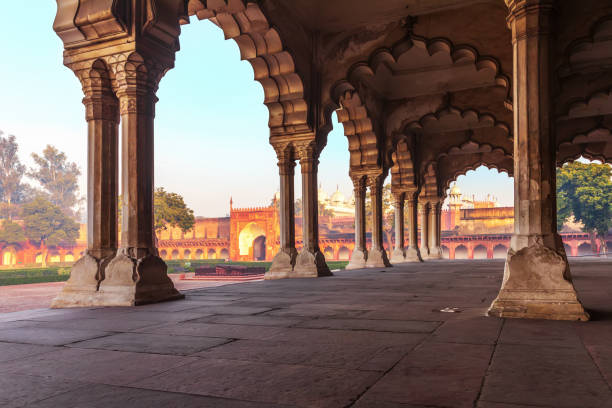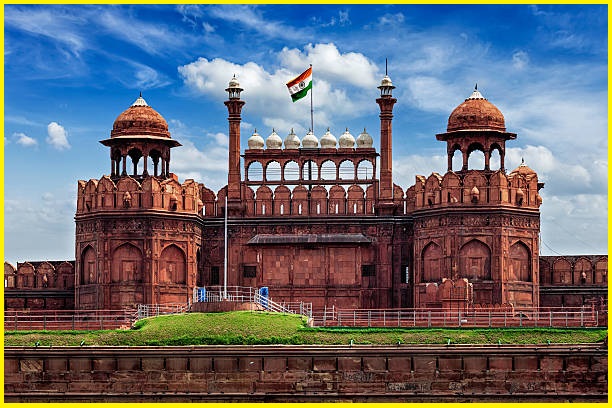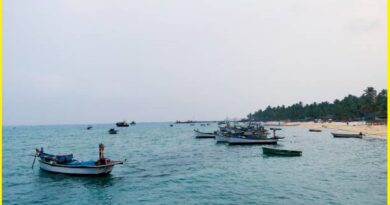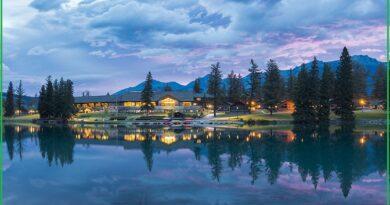Regal Resplendence- The Story of the ‘Red Fort Delhi’
The Red Fort
The Red Fort, also known as Lal Qila, is a historic fort located in the heart of Delhi, India. It is a UNESCO World Heritage Site and one of the most iconic landmarks in the city. The Red Fort was built by the Mughal Emperor Shah Jahan in the 17th century, between 1638 and 1648, as the main residence of the Mughal emperors.
The fort is famous for its imposing red sandstone walls, which gave it its name. Its architectural style reflects a blend of Persian, Timurid, and Indian architectural elements. The fort complex is spread over a vast area, with notable structures like the Diwan-i-Aam (Hall of Public Audience), the Diwan-i-Khas (Hall of Private Audience), the Moti Masjid (Pearl Mosque), the Nahr-i-Bihisht (Stream of Paradise), and the Rang Mahal (Palace of Colors), among others.
The Red Fort served as the main residence of the Mughal emperors for nearly 200 years until 1857, when the British colonial forces took control of Delhi after the Indian Rebellion of 1857. After India gained independence in 1947, the Red Fort became an important symbol of the nation and has since been the site where the Prime Minister hoists the national flag and delivers a speech every year on India’s Independence Day, which is celebrated on August 15th.
Who Built Red Fort
Emperor Shah Jahan commissioned the construction of the Red Fort on 12 May 1639, when he decided to shift his capital from Agra to Delhi. Originally red and white, its design is credited to architect Ustad Ahmad Lahori, who also constructed the Taj Mahal. The fort represents the peak in the Mughal architecture under Shah Jahan and combines Persian palace architecture with Indian traditions.

The fort was plundered of its artwork and jewels during Nader Shah’s invasion of the Mughal Empire in 1739. Most of the fort’s marble structures were subsequently demolished by the British following the Indian Rebellion of 1857. The fort’s defensive walls were largely undamaged, and the fortress was subsequently used as a garrison.
Also, Read- Qutub Minar-The Majestic Marvel and Delhi’s Iconic Landmark
Red Fort Timings
Structure within The Fort
The Delhi Gate
The Delhi Gate is one of the main entrances to the Red Fort complex. The Delhi Gate is located on the southern side of the Red Fort complex, facing toward the city of Delhi. Like the rest of the Red Fort, the Delhi Gate is constructed of red sandstone and showcases exquisite Mughal architectural design. It features intricate carvings, including floral motifs and inscriptions in Persian script. The Delhi Gate served as the ceremonial entrance to the Fort during the Mughal era. It was through this gate that the Mughal emperor would enter the fort in grand processions, particularly during important occasions such as festivals or state functions.
The Lahori Gate
The Lahori Gate is one of the most significant and iconic entrances to the Red Fort complex in Delhi. The Lahori Gate is situated on the western side of the Red Fort complex, facing the renowned Chandni Chowk area of Old Delhi. The gate derives its name from the city of Lahore, which is now in Pakistan. It is believed that the gate was named Lahori Gate because it faced the direction of Lahore, which was the capital of the Mughal Empire during certain periods of history.
Constructed of red sandstone, the Lahori Gate is an impressive structure adorned with intricate carvings and embellishments characteristic of Mughal architecture. It features a large central archway flanked by two smaller arches on either side. The Lahori Gate served as one of the main entrances to the Red Fort during the Mughal era. It was through this gate that the emperor and other dignitaries would enter the fort for ceremonial and administrative purposes.
Chhatta Chowk
Chhatta Chowk, also known as Meena Bazaar, is a covered market located inside the Red Fort complex. Chhatta Chowk is situated between the Lahori Gate, the main entrance of the Red Fort, and the Naqqar Khana, which served as the drum house.
Chhatta Chowk was built during the reign of Shah Jahan, the Mughal Emperor who commissioned the construction of the Red Fort. It was constructed in the mid-17th century and served as a bustling market where royal merchants and traders sold a variety of goods to the imperial court. The market is a covered bazaar with a long arcade supported by a series of columns and arches. The architecture reflects the grandeur and opulence of Mughal design, with intricately carved sandstone pillars and a high-arched ceiling.
Chhatta Chowk was designed to cater to the needs of the Mughal royalty and their courtiers. It offered a wide array of luxury goods, including textiles, jewelry, perfumes, silks, and other precious items. The name “Meena Bazaar” refers to the market’s association with the traditional bazaars where colorful enamel work (Meenakari) was popular. It is said that the women of the royal household frequented Meena Bazaar to shop for exquisite items.
Diwan-i-Aam
Diwan-i-Aam, also known as the Hall of Public Audience, is a prominent structure within the Fort complex. Diwan-i-Aam served as the hall where the Mughal Emperor would meet his subjects and address public audiences. It was a space for the emperor to receive petitions, listen to grievances, and interact with the common people.

Built during the reign of Shah Jahan, Diwan-i-Aam is an architectural masterpiece that exemplifies the grandeur and opulence of Mughal design. The hall features a high throne platform adorned with marble inlay work and a decorative canopy. Diwan-i-Aam is a large rectangular hall with a raised platform at one end where the emperor’s throne was placed. The hall is open on three sides, allowing for ample ventilation and natural light. The ceiling is adorned with intricate floral and geometric designs.
The hall is decorated with intricate marble carvings, including floral motifs, inscriptions in Persian script, and inlay work featuring semi-precious stones. The architectural details reflect the Mughal love for ornamentation and craftsmanship.
Diwan-i-Khas
Diwan-i-Khas, also known as the Hall of Private Audience, is a significant structure within the Red Fort complex. Diwan-i-Khas served as the hall where the Mughal Emperor held private audiences with select courtiers, nobles, and dignitaries. It was a more intimate space compared to the Diwan-i-Aam, reserved for confidential discussions and private meetings.
Built during the reign of Shah Jahan, Diwan-i-Khas is a masterpiece of Mughal architecture, characterized by its elegant design and intricate ornamentation. The hall features a central octagonal platform where the emperor’s throne was placed. Diwan-i-Khas is a square-shaped hall with a marble platform at its center. The platform is surrounded by intricately carved columns and arches, creating an open pavilion-style structure. The hall is adorned with marble inlay work, floral motifs, and inscriptions in Persian script.
The interior of Diwan-i-Khas is embellished with precious stones, including jade, onyx, and lapis lazuli, set into the marble walls. The famous “Peacock Throne,” adorned with jewels and featuring a canopy supported by golden pillars, was once housed in Diwan-i-Khas.
The Rang Mahal
The Rang Mahal, also known as the Palace of Colors, is a significant structure within the Red Fort complex. The Rang Mahal served as the royal residence for the Mughal emperor’s wives and concubines. It was a private quarters where the women of the royal household lived and carried out their daily activities.
Built during the reign of Shah Jahan, the Rang Mahal is an architectural marvel known for its elegant design and exquisite ornamentation. The palace features a blend of Persian, Timurid, and Indian architectural styles, with intricate carvings and decorative elements. The Rang Mahal is a multi-storied structure with a central courtyard surrounded by rooms and chambers. The palace is designed to provide privacy and comfort to the emperor’s female companions, with separate living quarters and facilities. The Rang Mahal witnessed the splendor and opulence of the Mughal court during its heyday. It was a center of cultural and social life, hosting lavish celebrations, musical performances, and artistic gatherings.
Places to visit near Red Fort
The Red Fort, the largest monument in Delhi, is one of its most popular tourist destinations and attracts thousands of visitors every year. It is a monument of national significance; every year on India’s Independence Day (15 August), the prime minister of India hoists the country’s flag at the Red Fort and delivers a nationally broadcast speech from its ramparts. The Red Fort is rich in historical and cultural attractions. Here are some places you can visit near the Red Fort-
Jama Masjid
Located just opposite the Red Fort, Jama Masjid is one of the largest mosques in India. It was also commissioned by Emperor Shah Jahan and completed in 1656. Visitors can admire its stunning architecture and climb the minarets for a panoramic view of Old Delhi.
Chandni Chowk
This bustling market area is adjacent to the Red Fort and offers a vibrant atmosphere with narrow lanes, old havelis (traditional Indian mansions), street food stalls, and shops selling everything from spices to textiles.
Raj Ghat
A short distance from the Red Fort is Raj Ghat, a memorial dedicated to Mahatma Gandhi, the father of the Indian nation. It is located on the banks of the Yamuna River and marks the spot where Gandhi was cremated after his assassination in 1948.

Shri Digambar Jain Lal Mandir
Situated near the Red Fort, this Jain temple is one of the oldest temples in Delhi and is known for its stunning architecture and intricate carvings.
Fatehpuri Masjid
Another significant mosque in Old Delhi, Fatehpuri Masjid was built by Fatehpuri Begum, one of Emperor Shah Jahan’s wives, in 1650. It features red sandstone and marble domes and is worth a visit for its architectural beauty.
Gurudwara Sis Ganj Sahib
Located in Chandni Chowk, this Sikh temple is a significant historical and religious site. It marks the place where the ninth Sikh Guru, Guru Tegh Bahadur, was martyred in 1675.
How to Reach Red Fort
The Delhi Metro is one of the most convenient ways to reach the Red Fort. The nearest metro station to the Red Fort is the Lal Qila Metro Station, which is on the Violet Line (Line 6) of the Delhi Metro. From the Lal Qila Metro Station, you can walk to the Red Fort in a few minutes.
By Bus
Delhi has an extensive bus network that connects different parts of the city, including the area around the Fort. You can use local buses or Delhi Transport Corporation (DTC) buses to reach the Red Fort. Several bus stops are located near the fort.
Auto-rickshaws and taxis are readily available throughout Delhi and can take you directly to the Red Fort. Make sure to negotiate the fare with the driver before starting your journey, and consider using a taxi app for more transparency in pricing. If you’re driving to the Red Fort, you can use GPS navigation to reach the fort’s location. The fort is located near Chandni Chowk in Old Delhi, and there are parking facilities available nearby.




